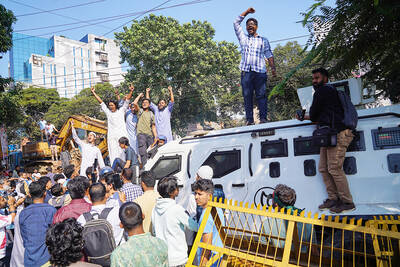Eighteen years after he was kidnapped by Mossad agents, nuclear whistleblower Mordechai Vanunu will go free this week -- a moment Israel fears will refocus unwelcome attention on its "bomb in the basement."
Anti-nuclear crusaders are flying in from Europe and the US for Wednesday's release, but they won't be able to embrace their hero.
Israel's security services, trying to quash celebrations and keep Vanunu silent, have barred him from speaking to foreigners, traveling abroad or even approaching foreign embassies for fear he might seek political asylum.
Vanunu, 50, said in remarks published yesterday that he has no more secrets to spill beyond what he told The Sunday Times of London in 1986 about his nine years as a technician at the Dimona nuclear reactor in the Negev Desert.
The US and Europe already know everything they need to know about Israel's nuclear program, Vanunu told Shin Bet interrogators two weeks ago, according to transcripts published in the Yediot Ahronot and Maariv dailies.
"As for myself, I just want to repeat the things I already said and that were published," Vanunu was quoted as saying.
Vanunu said he hoped there would be renewed debate about Israel's nuclear program and that the Dimona reactor should be destroyed, "like the reactor in Iraq was destroyed." Israel bombed the Iraqi reactor in 1981.
Based on Vanunu's descriptions and the photographs he secretly took inside the Dimona reactor, foreign experts said in 1986 that Israel had the world's sixth-largest stockpile of nuclear weapons. Such revelations undercut Israel's policy of "nuclear ambiguity."
That policy was forged in the 1960s when Israel promised the US it would not declare its nuclear status, test nuclear weapons or use them for political gain, wrote Israeli historian Avner Cohen on the Web site of the Bulletin of the Atomic Scientists, an academic journal in the US. In exchange, Washington did not pressure Israel to disarm.
Israel has kept the pledge, neither confirming nor denying it has nuclear capability. Some say that by drawing attention to its nuclear capability, Vanunu actually boosted Israel's security.
"There is no question that more than anybody, he (Vanunu) contributed to Israeli deterrence," Cohen said.
Vanunu is celebrated by anti-nuclear campaigners abroad. He received thousands of letters of support while in prison, was formally adopted by an elderly couple from Minnesota and had celebrities and members of the US Congress lobby on his behalf.
But there is little sympathy for him in Israel, a country where just about everything is debated openly -- except nuclear weapons.
Israelis believe the weapons are their last line of defense, "the ultimate guarantee that another Holocaust will not happen," said legal commentator Moshe Negbi. The consensus is that too much talk will only harm security.
Still, critics say, Vanunu's punishment was excessive, considering that he didn't reveal anything Israel's enemies didn't already suspect.
Those in charge of security at Dimona ignored many warning signs that Vanunu was drawn into left-wing and pacifist circles while still working at the reactor, said Yossi Melman, a journalist who writes about espionage.
Vanunu said Israel shouldn't have trusted him with sensitive information and that the "bigshot psychologists" from the Shin Bet and the Mossad security services should have spotted him as a potential security risk.
"You gave information to the wrong man," Maariv quoted him as saying. However, he insisted he was not a spy.
Vanunu was snatched from Rome by the Mossad in 1986 after being lured into a rendezvous by a female agent, smuggled to Israel by yacht, tried behind closed doors and sentenced to 18 years for treason. He spent 12 of those years in solitary confinement.
In the 30 months, Vanunu was under 24-hour video surveillance, with fluorescent lights on at all times in his windowless cell, said his brother Meir. He was allowed a one-hour daily walk in a yard shrouded in canvas to prevent him from signaling other prisoners. His only human contact was a guard and a family visit every two weeks.
Yediot and Maariv ran rare photographs of the white-haired, balding Vanunu yesterday, showing him in jeans, a brown prison uniform shirt and a blue ski jacket. Vanunu, a convert to Christianity, wore a gold cross around his neck and held a copy of the International Herald Tribune.
The prisoner, one of 11 children of working-class Jewish immigrants from Morocco, seems to have been an accidental spy.
He was a loner who rebelled against his ultra-Orthodox Jewish upbringing and searched for a place to belong. He studied at Ben Gurion University in the Negev while working at the reactor, joining pacifist and Arab-Jewish groups on campus, and earned an undergraduate degree in philosophy.
In 1985, after getting fired from Dimona, Vanunu flew to Thailand, where he stayed at a Buddhist monastery and considered conversion, then moved on to Australia. He became a Christian, changed his name to John Crossman, joined an Anglican congregation in Sydney and met a freelance journalist who suggested Vanunu talk to the media about Dimona. The Sunday Times was interested.
The Israeli government is trying to limit the damage caused by Vanunu's release by imposing restrictions on his movement, with the implicit threat of re-arrest if he violates them.
"We just want to stop him from spreading state secrets," said Likud Party legislator Yuval Steinitz, chairman of parliament's Defense and Foreign Affairs Committee.
"We think Vanunu still has information he hasn't revealed," Steinitz said.

DISASTER: The Bangladesh Meteorological Department recorded a magnitude 5.7 and tremors reached as far as Kolkata, India, more than 300km away from the epicenter A powerful earthquake struck Bangladesh yesterday outside the crowded capital, Dhaka, killing at least five people and injuring about a hundred, the government said. The magnitude 5.5 quake struck at 10:38am near Narsingdi, Bangladesh, about 33km from Dhaka, the US Geological Survey (USGS) said. The earthquake sparked fear and chaos with many in the Muslim-majority nation of 170 million people at home on their day off. AFP reporters in Dhaka said they saw people weeping in the streets while others appeared shocked. Bangladesh Interim Leader Muhammad Yunus expressed his “deep shock and sorrow over the news of casualties in various districts.” At least five people,

LEFT AND RIGHT: Battling anti-incumbent, anticommunist sentiment, Jeanette Jara had a precarious lead over far-right Jose Antonio Kast as they look to the Dec. 14 run Leftist candidate Jeannette Jara and far-right leader Jose Antonio Kast are to go head-to-head in Chile’s presidential runoff after topping Sunday’s first round of voting in an election dominated by fears of violent crime. With 99 percent of the results counted, Jara, a 51-year-old communist running on behalf of an eight-party coalition, won 26.85 percent, compared with 23.93 percent for Kast, the Servel electoral service said. The election was dominated by deep concern over a surge in murders, kidnappings and extortion widely blamed on foreign crime gangs. Kast, 59, has vowed to build walls, fences and trenches along Chile’s border with Bolivia to

DEATH SENTENCE: The ousted leader said she was willing to attend a fresh trial outside Bangladesh where the ruling would not be a ‘foregone conclusion’ Bangladesh’s fugitive former prime minister Sheikh Hasina yesterday called the guilty verdict and death sentence in her crimes against humanity trial “biased and politically motivated.” Hasina, 78, defied court orders that she return from India to attend her trial about whether she ordered a deadly crackdown against the student-led uprising that ousted her. She was found guilty and sentenced to death earlier yesterday. “The verdicts announced against me have been made by a rigged tribunal established and presided over by an unelected government with no democratic mandate,” Hasina said in a statement issued from hiding in India. “They are biased and politically motivated,” she

It is one of the world’s most famous unsolved codes whose answer could sell for a fortune — but two US friends say they have already found the secret hidden by Kryptos. The S-shaped copper sculpture has baffled cryptography enthusiasts since its 1990 installation on the grounds of the CIA headquarters in Virginia, with three of its four messages deciphered so far. Yet K4, the final passage, has kept codebreakers scratching their heads. Sculptor Jim Sanborn, 80, has been so overwhelmed by guesses that he started charging US$50 for each response. Sanborn in August announced he would auction the 97-character solution to K4